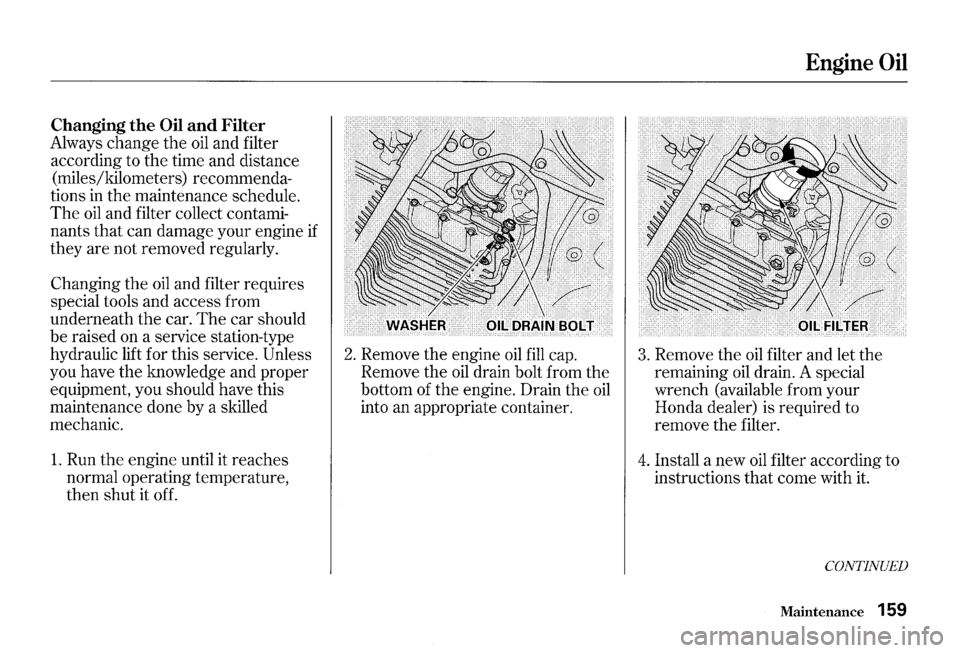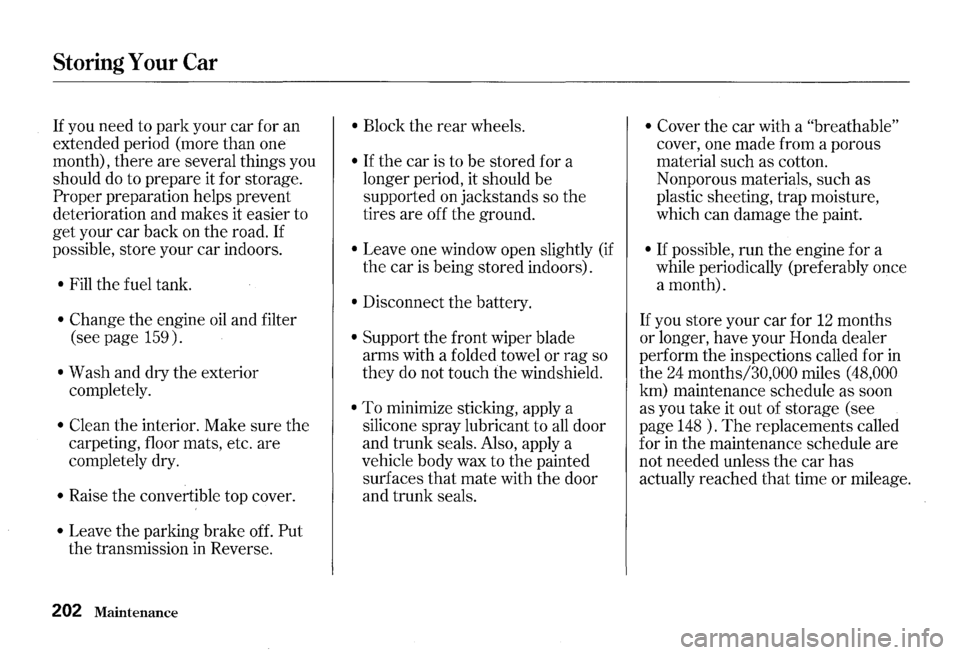2000 HONDA S2000 oil change
[x] Cancel search: oil changePage 42 of 273

Your car's exhaust contains carbon
monoxide gas.
You should have no
problem with carbon monoxide
entering the car in normal driving
if
you maintain your car properly.
Have the exhaust system inspected
for leaks whenever:
• The car is raised for an oil change.
• You notice a change in the sound
of
the exhaust.
• The car was in an accident that
may have damaged the underside.
Carbon monoxide gas is toxic.
Breathing it can cause
unconsciousness and even
kill
you.
Avoid any
enclosed areas or
activities that expose you to
carbon monoxide.
High levels of carbon monoxide can
collect rapidly in enclosed areas,
such as a garage. Do not run the
engine with the garage door closed.
Even with the door open, run the
engine only long enough to move the
car out of the garage.
Carbon Monoxide Hazard
With the trunk lid open, air flow can
pull exhaust gas into your vehicle's
interior and create a hazardous
condition.
If you must drive with the
trunk lid open, open
all the windows
and set the heating and cooling
system as shown below.
If you must sit in your parked car,
even
in an unconfined area, with the
engine running, adjust the heating
and cooling system as follows:
1. Push the ~ button.
2. Select the w mode.
3. Turn the fan on high speed.
4. Set the temperature control to a
comfortable setting.
Driver and Passenger Safety 39
Page 143 of 273

Driving in Bad Weather
Rain, fog, and snow conditions re
quire a different driving technique
because of reduced traction and
visibility. Keep your car well
maintained and exercise greater
caution when you need to drive in
bad weather.
The cruise control
should not be used in these condi
tions.
140 Driving
Driving Technique -Always drive
slower than you would
in dry
weather.
It takes your car longer to
react, even
in conditions that may
seem just barely damp. Apply
smooth, even pressure to
all the
controls. Abrupt steering wheel
movements or sudden, hard appli
cation of the brakes can cause loss of
control in wet weather. Be extra
cautious for the first few miles
(kilometers) of driving while you
adjust to the change in driving
conditions.
This is especially true in
snow. A person can forget some
snow-driving techniques during the
summer months.
Practice is needed
to relearn those skills.
Exercise extra caution when driving
in rain after a long dry spell. After
months of dry weather, the first
rains bring
oil to the surface of the
roadway, making it slippery.
Visibility -Being able to see
clearly in
all directions and being
visible to other drivers are important
in all weather conditions. This is
more difficult
in bad weather. To be
seen more clearly during daylight
hours, turn on your headlights.
Inspect your windshield wipers and
washers frequently. Keep the wind
shield washer reservoir full of the
proper fluid. Have the windshield
wiper blades replaced
if they start to
streak the windshield or leave parts
unwiped.
Use the defrosters and air
conditioning to keep the windows
from fogging up on
the inside (see
page
91 ).
Page 161 of 273

Engine Oil
The oil container may also display
the
API Certification seal. Make sure
it says
"For Gasoline Engines."
158 Maintenance
The SAE numbers tell you the oil's
viscosity or weight. Select the
oil for
your car according to this chart.
60
. 10 20
" ~ c" ' -c '
AnlbielltTertlperature
An oil with a viscosity of lOW-30 is
preferred for improved fuel economy
and year-round protection in your
Honda.
You may use a 5W-40 oil if
the temperature in your area goes
below oaF (
-20°C).
Synthetic Oil
You may use a synthetic motor oil if
it meets the same requirements
given for conventional motor
oil:
energy conserving, a service
classification of
SJ, and the proper
weight as shown on the chart. When
using synthetic
oil, you must follow
the
oil and filter change intervals
given
in the maintenance schedule.
Additives
Your Honda does not need any oil
additives. Purchasing additives for
the engine or transmission will not
increase your car's performance or
longevity.
It only increases the cost
of operating your car.
Page 162 of 273

Changing the Oil and Filter
Always change the oil and filter
according to the time and distance
(miles/kilometers) recommenda
tions
in the maintenance schedule.
The oil and filter collect contami
nants that can damage your engine
if
they are not removed regularly.
Changing the
oil and filter requires
special tools and access from
underneath
the car. The car should
be raised on a service station-type
hydraulic lift for this service.
Unless
you have the knowledge and proper
equipment, you should have this
maintenance done by a skilled
mechanic.
1. Run the engine until it reaches
normal operating temperature,
then shut it off.
2. Remove the engine oil fill cap.
Remove the
oil drain bolt from the
bottom of
the engine. Drain the oil
into an appropriate container.
Engine Oil
3. Remove the oil filter and let the
remaining
oil drain. A special
wrench (available from your
Honda dealer) is required to
remove the filter.
4. Install a new oil filter according to
instructions that come with it.
CONTINUED
Maintenance 159
Page 163 of 273

Engine Oil
5. Put a new washer on the drain bolt,
then reinstall the drain bolt.
Tighten it to:
33 lbf.ft (45 N·m, 4.6 kgf·m)
6. Refill the engine with the recom
mended
oil.
Engine oil change capacity
(including filter):
5.1 US qt (4.8 Q, 4.2 Imp qt)
7. Install the engine oil fill cap. Start
the engine. The oil pressure
indicator light should go out within
five seconds. If it does not, turn off
the engine and reinspect your
work.
8. Let the engine run for several
minutes and check the drain bolt
and
oil filter for leaks.
160 Maintenance
9. Turn off the engine, let it sit for
several minutes, then check the
oil
level. If necessary, add oil to bring
the level to the upper mark on the
dipstick.
NOTICE
Improper disposal of engine oil can be
harmful
to the environment. If you
change your own oil, please dispose
of
the used oil properly. Put it in a sealed
container and take it
to a recycling
center. Do not discard it
in a trash bin
or dump it on the ground.
Page 197 of 273

Lights
Replacing a Headlight Bulb
The low beam headlight bulbs are a
type of high voltage discharge tube.
High voltage can remain in
the
circuit even with the light switch off
and the key removed. Because of
this, you should not attempt to
examine or change a low beam
headlight bulb yourself.
If a low
beam headlight bulb fails, take the
car to your dealer to have it replaced.
194 Maintenance
Halogen bulbs are used for the high
beam headlight bulbs.
When
replacing a high beam headlight bulb,
handle it by its base and protect the
glass from contact with your skin or
hard objects.
If you touch the glass,
clean it with denatured alcohol and a
clean cloth.
NOTICE
Halogen headlight bulbs get very hot
when
lit. Oil, perspiration, or a scratch
on the glass can cause the bulb to
overheat and shatter.
Page 205 of 273

Storing Your Car
If you need to park your car for an
extended period (more than one
month), there are several things you
should
do to prepare it for storage.
Proper preparation helps prevent
deterioration and makes it easier to
get your car back on the road.
If
possible, store your car indoors.
• Fill the fuel tank.
• Change the engine oil and filter
(see page 159).
• Wash and dry the exterior
completely.
• Clean the interior. Make sure the
carpeting, floor mats, etc. are
completely dry.
• Raise the convertible top cover.
• Leave the parking brake off. Put
the transmission in Reverse.
202 Maintenance
• Block the rear wheels.
• If the car is to be stored for a
longer period, it should be
supported on jackstands so the
tires are off the ground.
• Leave one window open slightly (if
the car is being stored indoors).
• Disconnect the battery.
• Support the front wiper blade
arms with a folded towel or rag so
they
do not touch the windshield.
• To minimize sticking, apply a
silicone spray lubricant to
all door
and trunk seals. Also, apply a
vehicle body wax to the painted
surfaces that mate with the door
and trunk seals.
• Cover the car with a "breathable"
cover, one made from a porous
material such as cotton.
Nonporous materials, such as
plastic sheeting, trap moisture,
which can damage
the paint.
• If possible, run the engine for a
while periodically (preferably once
a month).
If you store your car for 12 months
or longer, have your Honda dealer
perform the inspections called for
in
the 24 months/30,000 miles (48,000
km) maintenance schedule as soon
as you take it out of storage (see
page
148 ). The replacements called
for
in the maintenance schedule are
not needed unless the car has
actually reached that time or mileage.
Page 247 of 273

Specifications
Dimensions
Length
Width Height
Wheelbase Track Front
Rear
Engine
Type
Bore x Stroke
Displacement
Compression ratio
Spark plugs
244 Technical Information
162.0in(4,115mm) 68.9 in (1,750 mm)
50.6 in (1,285 mm) 94.5 in (2,400 mm)
57.9 in (1,470 mm)
59.4 in (1,510 mm)
See the certification label attached to the driver's door"amb.
Water cooled 4-stroke DOHC
VTEC 4-cylinder l=)asoline engine
3.43 x 3.31 in (87.0 x 84.0 mm)
121.8 cu-in (1,997 cm3
)
11.0 : 1 See spark plug maintenance
section page
174.
c apac1t1es
Fuel tank 13.2 US
aal (50 ll, 11.0 Imp qal)
Engine coolant
Change*'
1.72 US aal (6.51\, 1.43 Imp qal)
Total 2.01 US l=)al (7.61\, 1.67 Imp gal)
Engine oil Change*'
Including filter 5.1 US qt (4.81\, 4.2 Imp qt)
Without
filter 4.8 USgt (4.51\, 4.0 Imp qt)
Total 5.9 US qt (5.61\, 4.9 Imp qt)
Manual Chanl=)e 1.6 US_g_t (1.51\, 1.31mp qt)
transmission Total 1.7 US qt (1.61\, 1.41mp qt) fluid
Differential Chan_g_e 0.78 US qt (0.741\, 0.65 Imp qt)
oil Total 0.81 US qt (0.77 ll, 0.68 Imp at)
Windshield U.S. Cars 2.7 US qt (2.61\, 2.3 ImP at)
washer Canadian Cars 4.4 US qt (4.21\, 3.7 Imp qt)
reservoir
* 1 : Including the coolant in the reserve tank and that remaining in the
engine. Reserve tank capacity:
0.16 US gal (0.61\, 0.131mp gal)
* 2: Excluding the oil remaining in the engine.